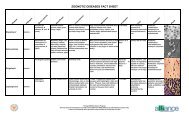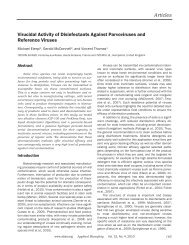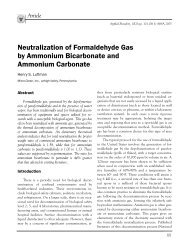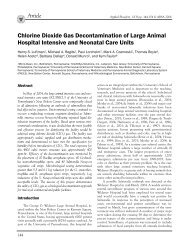Volume 10, Number 4, 2005 - American Biological Safety Association
Volume 10, Number 4, 2005 - American Biological Safety Association
Volume 10, Number 4, 2005 - American Biological Safety Association
Create successful ePaper yourself
Turn your PDF publications into a flip-book with our unique Google optimized e-Paper software.
ating. Unfortunately, both of these tests failed.<br />
Based on the information in the preceding table,<br />
it was evident that the results varied greatly with<br />
each autoclave due to the type of autoclave and differences<br />
in cycle times and temperatures. However,<br />
it can be shown that the shorter-timed cycles failed<br />
consistently for each challenge load tested. The exceptions<br />
to this were the results generated from the<br />
Amsco 3041 autoclave and the Amsco Scientific<br />
autoclave. For the Amsco 3041 autoclave, the 250<br />
mL of water added to the autoclave bag helped with<br />
the sterilization of the materials, resulting in a passing<br />
test for the challenge load. The Amsco Scientific<br />
autoclave was able to sterilize the PROSPORE2 biological<br />
indicator using a 30-minute cycle because of<br />
the higher temperature setting. However, the bags<br />
used for this autoclave were not compatible with the<br />
higher temperature, resulting in complete deterioration<br />
of the bags after autoclaving.<br />
Additional Findings<br />
It was observed that not all autoclaves had clear<br />
instructions available detailing proper usage and that<br />
no user log was present to record the users, cycle<br />
times, settings, and autoclave contents. In addition,<br />
it was unknown if the temperature sensors on each<br />
autoclave were properly calibrated due to inadequate<br />
record keeping concerning general maintenance on<br />
several autoclaves. However, each autoclave chamber<br />
temperature was verified during the runs using a<br />
high-low thermometer that was placed in the autoclave<br />
with each challenge load run. There was good<br />
consistency between the high-low thermometer temperature<br />
readings and the temperature indicated on<br />
the autoclaves.<br />
In addition, no records were kept to indicate<br />
when general or safety maintenance was last conducted<br />
on several autoclaves. Maintenance should be<br />
done yearly or as recommended by the autoclave<br />
manufacturer.<br />
Recommendations<br />
In keeping with the CDC and OSHA recommendations<br />
and using F.A.C. 64E-16.007 as a guide-<br />
R. N. Le, et al.<br />
line, EH&S will use biological indicators for validating<br />
the steam sterilization cycles on an annual basis.<br />
EH&S recommends that the following adjustments<br />
to policies and practices be implemented in order to<br />
better achieve sterilization and ensure proper maintenance<br />
for each autoclave:<br />
1. Readjustment of Cycle Times<br />
The standard 121°C, 15-psi, and 15-minute<br />
dwell time are adequate for sterilization of clean<br />
items or smaller loads, but were found to be inadequate<br />
for large bulky loads of biohazardous waste.<br />
For this type of waste, it is recommended that the<br />
sterilization time be increased to a minimum of 60<br />
minutes, while still maintaining the standard temperature<br />
and pressure. This setting has proven effective<br />
for sterilizing larger loads. The addition of water<br />
is not recommended because results were not consistent<br />
enough for this to be considered an effective<br />
option. It is also recommended not to leave the autoclave<br />
bag open for actual autoclaving of materials<br />
even though this procedure was used in the test procedure.<br />
The bag should be secured loosely with a<br />
rubberband or closed loosely with a small opening<br />
(at least 1 inch in diameter). This will minimize an<br />
individual’s risk of becoming exposed to hot materials<br />
within the bag. It is suggested that a “kill cycle”<br />
be set on each autoclave intended specifically for<br />
sterilization of contaminated dry waste loads.<br />
The Amsco Scientific autoclave did yield a passing<br />
result due to a higher temperature setting. However,<br />
the autoclave bags used could not withstand<br />
the higher temperature and the bags deteriorated<br />
during the procedure. This is a safety concern because<br />
the contents within the bag could spill onto<br />
the user exposing him or her to the extremely hot<br />
contents. To use this autoclave at the higher temperature<br />
settings, it is important to use an autoclave<br />
bag that is compatible with the 132°C temperature.<br />
In addition, the autoclaves should be retested using<br />
the new autoclave bags.<br />
2. Proper Autoclave Use<br />
The autoclave bag should never be over-packed<br />
or sealed too tightly. It is also important to make<br />
sure that the contents of the autoclave bag are kept<br />
at a minimum. An over-packed bag will insulate mi-<br />
251







